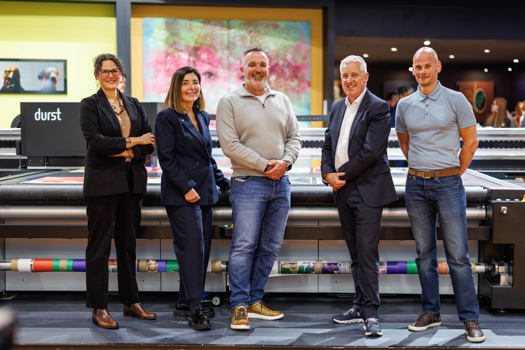It’s hard to think of much that’s positive at all about the past two years’ Covid-19 crisis, certainly in human terms, but in the long term we may be able to look back and say that it accelerated some print industry trends that would otherwise have taken years to happen.
Home working is the most obvious, though that only works up to a point in the printing industry, which remains necessarily hands-on and centralised at the point of actually producing things. Rather more subtle is the way that restrictions in movement for maintenance engineers has accelerated moves to remotely monitor, analyse, diagnose and sometimes fix systems, sometimes also to improve production methods and efficiencies.
These trends are part of long-term development efforts to apply always-on connectivity (‘Internet of Things’), machine learning, artificial intelligence and ever-increasing automation to production, leading to what the marketing bods call ‘smart factories’ or ‘Industry 4.0’.
While it all sounds a bit ‘white heat of technology’, it’s worth noting that the side-effects include de-skilling of operator tasks and an underlying hint of Big Brother AI watching you all the time and comparing the performance of individuals, teams and whole companies. All in the name of efficiency.
Many of today’s equipment suppliers build in the sensors and communications hooks to be able to offer remote diagnostics and possibly remote fixing. Only the largest so far can offer the analytics that build up patterns of usage and offer solutions based on a mix of human experience and machine learning. This may change if projects like Alphabet/Google’s DeepMind Technologies subsidiary result in some form of easily accessible and applicable artificial intelligence for all.
Heidelberg has been one of the most vocal companies concerning the application of analytics to remote monitoring in recent years. It’s built on the sensors and connectivity of its Prinect factory network technology to offer a series of remote help levels for both maintenance and productivity.
“On presses, data capture is driving performance,” says Paul Chamberlain, who is head of software solutions for Northern Europe, and head of performance consulting for the UK. “This can help with waste management and makeready, for example Analyse Point from Prinect, or Production Manager that has been available for years. You can get a lot of data from the start-stop, run lengths, etc.
“This is useful for training, as it can analyse the press performance, waste, makeready, etc. For example, it may be that every time a certain operator runs lightweight stock it takes longer than with other operators, so that might indicate that more training is required.
“Our Smart Business Intelligence takes data from the Prinect Business Manager MIS and Analyse Point to create a dashboard and reports. New in 2019 was Heidelberg Assistant with now 120 users in the UK and 3,500 globally. This has interactive communications and is good for showing a snapshot of overall business efficiency.”
Advice on tap
Artificial intelligence is used in the new Performance Advisor Technology (PAT), Chamberlain says. “PAT is more about helping with live production rather than machine maintenance. This helps customers with performance suggestions when running jobs. It is able to give recommendations on how to improve the efficiency of a particular job. Say the feeder keeps checking out, with say double sheets. PAT can recommend various adjustments, and the operator acknowledges these and can try them. PAT will then monitor if it works, and if so it will use it as part of its knowledge base for future recommendations to other sites and customers.”
This all comes into the idea of Print 4.0, Chamberlain says. “We say there are four key pillars to drive a print shop in 4.0: estimating – optimising the end-to-end process, reducing touch points; scheduling – sheet sizes, delivery dates, etc; substrate types; and consumables – ink/water balance, colour control, etc. We are looking at automation of these four main areas. We need to measure for that, so that’s where the data comes in.”
RMGT has also found remote services a help in the pandemic, says Steve Ennew, UK & Ireland technical sales manager for RMGT’s agent M Partners. “Long before the Covid-19 pandemic struck RMGT was introducing remote systems to further aid the reliability of the presses, but also to create a cost-effective solution for the end-user. Visualisation of the presses is key as technologies advance and there are further developments within the realm of AI. RMGT has already introduced robots, working alongside the minder to further automate the presses, so the future does look to be here.
“Every press we now offer will have an option of RMGT Cloud connection. This centralised system collects, browses and analyses production status, such as waste sheets, operator performance, etc, all available on mobile devices such as smartphone, tablet and PC in real time. RMGT provides this facility as the Press Information Cloud Package and it’s free to the end-user.
“We’ll see implementation of solutions through optimum prediction of any given issue. Reducing waste, increasing run speeds or replacing a press part that is operating outside its selected parameters are just a few examples. As more and more technologies move into this space the potential for an almost autonomous printing press that is both efficient and self-governing is going to become more of a reality.”
Sylvain Faligand has run the HP Print Industrial Business Services operation for the past four years, based in Barcelona. This covers the HP Indigo digital presses, PageWide high-speed inkjet webs and corrugated, and 3D print systems. “It’s a worldwide organisation delivering installation, training, production ramp-up, production management special professional services for workflows, colour management, increasing productivity, materials use and covering the demand for more sustainable and secure solutions,” he explains.
He says HP was already ahead of the curve before lockdowns began. “The product divisions had already developed intelligence to improve diagnostics, via PPC (predictive and proactive care). In the past three years we improved the modelling, the algorithm and added more alerts to be able to predict problems before they happened. HP Indigo systems can all send info to us in the cloud. Also there is PPC incorporated in the press consoles so they can show predictive and proactive messages for the operators to act on without the help of a technician. So it analyses the data globally but lets users act on it locally. Large-format, Indigo, PageWide, all have this – the sensors and machine-based learning to detect errors and propose diagnostics.
“On Indigo presses, we have a tool called Remote@Glance. If a customer calls in we can see the complete context of the job and recommend on it. In April-June 2020 we accelerated deployment of this tool across our systems. It knows what users have already done to try to fix something so it doesn’t duplicate troubleshooting activities, and it has analytics to recommend any additional elements. We can suggest to the operator that they visit the video for more knowledge or follow a specific procedure.
“Through PrintOS we also report to every customer the statistics on production, or open cases. They can see how they perform against their peers in their country or region. We don’t rate individuals so there are no confidentiality issues, but we do rate sites against similar sites. “Management can see how their business is performing. It will let them draw up action plans for their operations.”
In June Bobst announced a brand new cloud version of its remote monitoring and diagnosis services, that it calls Bobst Connect. This will be launched in September and by next year all new installations will have Connect systems fitted as standard, while existing installations will be upgradable unless they are very old.
“Customers increasingly demand remote services,” says Olivier Laurrin, marketing director for Bobst Business Unit Services and Performance. “We are convinced that they will play a growing role. With our Maintenance Premium we already see 6% less unplanned maintenance.” Bobst Connect is linked to remote servicing and analysis, fault prediction and planned maintenance.
Bobst’s original system was developed by an external company, he says. “We had a remote solution for more than 10 years, and a lot of Bobst machines are connected. There are about 4,000 today, so we have a lot of experience at troubleshooting, with high satisfaction from customers.” The new service has been developed in-house, he says.
“We are piloting user cases around monitoring things such as noise, which may indicate problems. Based on our experience we may then be able to do something to prevent it. This is not yet on the market, but we are looking at it, together with Bobst Connect. So we analyse the data for pre-emptive maintenance needs. We are working to anticipate replacing parts, so if a technician is visiting he can take parts for something that may need it soon.”
Beyond troubleshooting
As with Heidelberg, Bobst is looking beyond maintenance issues, Laurrin says. “Remote is not just troubleshooting. With our portfolio of remote services, we also have human expertise available remotely. For example Job Analyst, which is some years old. When a customer may have a difficult job, where productivity is not good, they can send us the job details and our experts will help them with the job. We are now trying new ideas with customers around Connect and remote servers.”
UK finishing developer IBIS Integrated Bindery Systems is an example of a smaller firm that uses remote diagnostics without the fancy analytics side so far. Managing director John Cracknell says: “The restrictions on travel have meant that, for the first time in 21 years, we have had to support our sales agents’ technicians to install and commission new IBIS Smart-binders. In some cases these technicians have not received training. To do this we have used a combination of videos, video calling and remote diagnostics.
“Our remote diagnostics allow us to detect and advise solutions for hardware issues, for example when a sensor needs cleaning or re-calibration; adjustments to settings to optimise speed or handle difficult materials; help to set up complex matching of coded product from multiple sources; and even to identify and fix bugs in software systems.”
Hunkeler has offered remote access to its users for years, say Robin Brown, digital sales manager at UK distributor Friedheim International. However, given that a lot of its users work in direct mail or transactional print, data security is a big issue, he says. “It’s a secure link on the most clever machines – Gen 8 cutters and book lines. It’s installed via the Humanline interface, an extension of the control panel. It needs a secure VPN. The connection is only ever opened by the customer, so we can’t see things without that – they don’t want to let us see bank statements, for instance. If there is a technical issue the customer dials in and flags it up. This alerts Hunkeler to look inside the machine. Some Friedheim engineers have been granted a licence to use it and see it at their UK offices.
“We can monitor machine operations remotely, but mostly for us it is software-related issues, such as reading 2D barcodes. We had a customer during an install where we kept getting a fault with the barcode reading, though the hardware was fine. It turned out that the camera field of view was set too wide, so it could not make out the detail of the barcode. Hunkeler reset the field of view remotely.”
Jason Seaber, technical sales director of finishing systems specialist IFS, says: “The pandemic has accelerated investments in more digital print finishing and binding solutions with higher levels of automation and connectivity to the Internet of Things. This is a growing trend that I expect will continue for many years to come and early adopters of these new technologies will benefit the most and also find it easier to integrate Industry 4.0 technologies, such as robot arms and automated guided vehicles.”
He says that the Japanese finishing manufacturer Horizon has recently introduced iCE LiNK, a new cloud-based workflow solution that enables all compatible Horizon finishing and binding machinery to use the Internet of Things to send information to the cloud. It’s already available on some systems as standard, and can be added to most other new or existing Horizon products. It can then be accessed by any internet connected device. It can schedule maintenance ahead of time. From the dashboard interface, the operation stats of all connected Horizon machines can be viewed. Data is automatically analysed to help users optimise production.
Seaber says: “In most commercial printing operations, the finishing and bindery areas are normally the busiest areas of production and normally under the most pressure to get jobs completed on time, efficiently and with minimum waste. Horizon’s iCE LiNK will help customers to streamline their job workflows, reduce downtime and increase productivity and profit.”
Other features of iCE LiNK include remote support and diagnostics, plus software upgrades. iCE LiNK is available on subscription along with service maintenance options from Intelligent Finishing Systems.
There are three iCE LiNK levels. IoT Basic is available now and already with some UK users. Automation and Enterprise levels are coming in August and will also enable JDF and API connectivity to third party systems.
One comparative failure of IoT maintenance has been AR glasses used to transmit videos of faults to centralised engineering teams, and to superimpose instruction sets over the local engineer’s field of view. Bobst, Koenig & Bauer, HP and have offered AR remote maintenance for a few years. Asked about it for this story, Bobst and HP reported low take-up due to technical limitations. HP says it has a new much-improved system coming in the autumn.
So the data revolution may not be televised, yet, but it will certainly be analysed.










